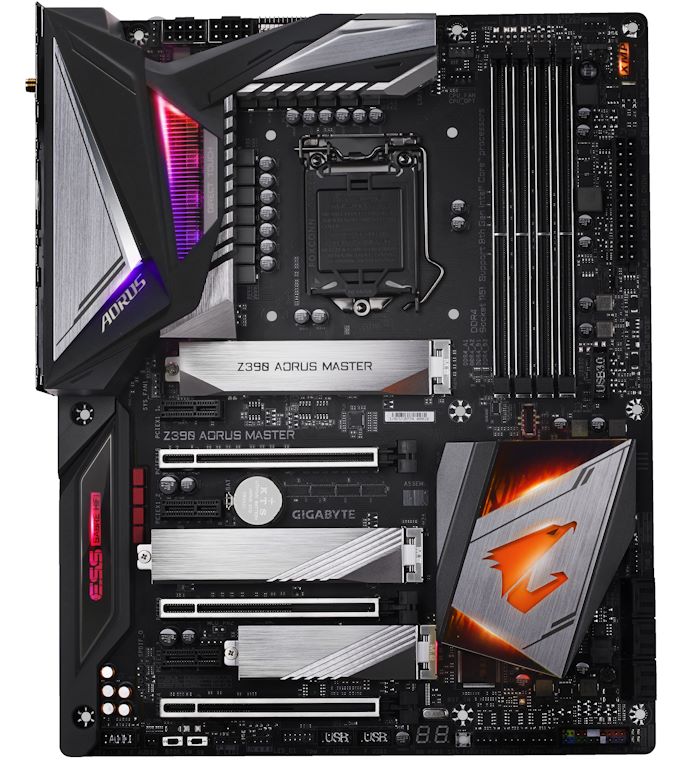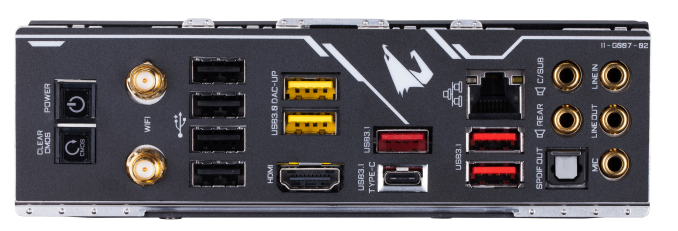Intel Z390 Motherboard Overview: 50+ Motherboards Analyzed
by Ian Cutress & Gavin Bonshor on October 8, 2018 10:53 AM EST- Posted in
- Motherboards
- Intel
- MSI
- Gigabyte
- ASRock
- EVGA
- Asus
- NZXT
- Supermicro
- Z390
GIGABYTE Z390 Aorus Master
Just like we noted in our AMD B450 launch motherboards overview, GIGABYTE has gone through a transitional period of late when it comes to branding. To make their naming scheme a little easier to decipher, the move isn't just for the benefit of users looking to distinguish between different types of motherboard, but it also allows GIGABYTE to tie in different components such as graphics cards and align them together from a marketing perspective. The new naming scheme essentially narrates the class of motherboard so for example, the AORUS Gaming 9 which was GIGABYTE's Z270 flagship is now known as the AORUS Xtreme. Other examples of GIGABYTE moving away from a numbering naming scheme include the AORUS Z390 Master which replaces the AORUS Z370 Gaming 7 and the Z390 Aorus Elite which is the successor of the Aorus Z370 Gaming 3. For the Z390 chipset launch GIGABYTE has announced a total of 11 new motherboards.
GIGABYTE Z390 Aorus Master
Starting off with one of the most unique offerings from GIGABYTE is the Z390 Aorus Master which is the only board from GIGABYTE's line up to feature a backplate. On top of this, the Z390 Aorus Master features triple PCIe 3.0 x4 M.2 slots which are all complemented with a set of M.2 heatsinks. The board is also equipped with a total of six SATA ports which has support for RAID 0,1,5 and 10 arrays. The GIGABYTE Z390 Aorus Master has support for up to DDR4-4133 with a maximum capacity of up to 64 GB across the four available RAM slots.
The GIGABYTE Z390 Aorus Master is a full-sized ATX motherboard and is advertised to have one of the most comprehensive power deliveries of their Z390 line-up with a 14-phase setup; probably in a 12+2 configuration. PCIe wise the board has a trio of PCIe 3.0 full-length slots with the top slot operating at x16, the second slot x8 and the third slot at x4; all three full-length slots feature metal slot reinforcement. The board does have support for two and three-way CrossFire and SLI multi-graphics configurations. In addition to this is three PCIe 3.0 x1 slots which sit above each full-length slot. Along the bottom side of the motherboard is an LED debug and the Master benefits from dual BIOS with the selector switches located along the bottom full-length PCIe slot.
Design wise the Z390 Aorus Master looks rather familiar and resembles the Z370 Gaming 7 which this model seemingly replaces and slots in between the new Z390 Aorus Xtreme and the Z390 Aorus Ultra models which puts the Master as one of GIGABYTE's top models. The Master has a full rear IO cover which extends across the VCore power delivery heat sink and also benefits from a pre-installed rear IO shield. Style wise the board offers multi-zone integrated RGB LEDs into the rear panel cover, the chipset heatsink and across the cover which sits across over audio PCB section.
The rear panel consists of three USB 3.1 Gen2 Type-A ports, a single USB 3.1 Gen2 Type-C port and four USB 2.0 ports; the board does have two USB 3.0 Type-A ports too which give support for GIGABYTE's DAC-UP audio technology. The five 3.5mm audio jacks and the S/PDIF optical output are controlled by a Realtek ALC1220-VB HD audio codec which includes an ESS Sabre 9118 DAC and the single LAN port takes its direction from an Intel I219V Gigabit controller. A single HDMI video output is present along with a Clear CMOS and rear panel power switch which sits next to two antennae tugs which support 2T2R Wave 2 compatible 802.11 Wi-Fi connections.
It's clear that the Z390 Aorus Master is targeted towards the enthusiast looking to make use of one of higher end 9th generation Intel processors such as the new eight-core processors which include the Core i9-9700K and Core i9-9900K which are due to launch a couple of weeks after the initial Z390 motherboard launch. The board has some overclocking credence to it with its advertised 14-phase power delivery and users looking to utilize the integrated Wave 2 capable 802.11ac and Bluetooth 5 connectivity, the Z390 Aorus Master is one for the shortlist. GIGABYTE has set an MSRP of $290 at launch which makes the Z390 Aorus Master the most expensive option in its current Z390 stack.












79 Comments
View All Comments
di4b0liko - Tuesday, November 20, 2018 - link
Asus ROG STRIX Z390-F or asrock taichi ?pradeep.ramalingam - Friday, November 23, 2018 - link
Hi,I was wondering whether "MSI MPG Z390M Gaming Edge AC" with processor "Intel i5-9600K" will it work with onboard graphics (Intel® UHD Graphics 630) without a GPU from nvidia/amd?
Tigrou - Tuesday, January 15, 2019 - link
"Z390 Motherboard Audio" panel in conclusion is incorrect. For example the MSI Z-390 A PRO has ALC892 but it is not in the list.Faslane - Wednesday, February 27, 2019 - link
Can you do a more in-depth overclocking guide for this board or is there one? if so may I please have a link to just a basic overclocking guide for this board? I have the board and loved it and I know I can go into the phantom gaming 4 app of course but I would rather do it at the BIOS level and save various profiles for testing but I'm a little new to some of the overclocking stuff but I do have a water cooled system with an 8th gen i5 9706 core so I know I can push it quite a bit :-)lb1966 - Thursday, April 11, 2019 - link
Just bought an IBuyPower with this MB init.Anybody able to hook it up to a home theater receiver?
7.1 sounds great on the headphones but I gotta take them off every once in while. Can I use the rear audio panel?
electricjedi - Thursday, January 9, 2020 - link
re: Asrock z390 gaming 4I know this does have a thunderbolt 5 pin header on the board, is this for thunderbolt 3?
Will the Asrock Thunderbolt 3 AIC R2.0 pci-e card work with this board?
or would I be smarter to get the GIGABYTE GC-ALPINE RIDGE (Rev 2.0) Thunderbolt3 Certified PCI-E Expansion card (since I know the z390 is "alpine ridge").
catminister - Saturday, November 28, 2020 - link
Also keep in mind that this board has no support for PCIe 4.0 or WIFI 6 802.11 AX in fact, it seems that Gigabyte abandons this board once purchased. If you want PCIe 4.0 to get the most out of the new Gen 4 NVMe M.2 drives or 802.11 AX support you are going to have to spend up and buy the X570 and a new CPU because socket 1151 is finished. A huge disappointment after recently upgrading to an Gigabyte Aorus Pro Wifi only this year...Turon - Saturday, December 25, 2021 - link
i can’t find the second ssd slot for the life of me, plz help.